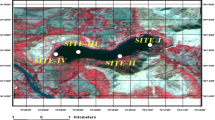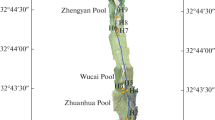Abstract
Water quality and bacterial diversity in the surface water of Rawal Lake was investigated for a period of 8 months to evaluate the pollution load from anthropogenic effects of surrounding areas. Rawal Lake in Islamabad, Pakistan is an artificial reservoir that provides the water needs for the residents of Rawalpindi and Islamabad. Grabbed water samples were collected according to standard protocols from ten different locations of the lake and tributaries keeping in view the recharge points from adjacent areas. Temperature, pH, electrical conductivity, dissolved oxygen, total dissolved solids, hardness, alkalinity, and turbidity of water samples were determined to study the water quality characteristics. The physicochemical parameters showed higher values at the tributaries as compared to the sampling locations within the lake such as values of hardness and alkalinity were 298 and 244 mg/L, respectively, at the tributary of the Nurpur stream. Bacterial strains were isolated by streaking on differential and selective growth media by observing colony morphology and other biochemical tests such as Gram reaction, oxidase, and catalase test. Template DNA was prepared from pure cultivated bacteria and 16S rRNA gene analysis was performed using universal primers for bacteria. Sequencing was performed by using BigDye terminator cycle sequencing kit. Sequences of nearest relative microbial species were identified by using basic local alignment search tool and used as reference sequences for phylogenetic analysis. Phylogenetic trees were inferred using the neighbor-joining method. Sequencing and phylogenetic characterization of microbes showed various phylotypes, of which Firmicutes, Teobacteria, and Proteobacteria were predominant.







Similar content being viewed by others

References
Aftab, N. (2010). Haphazard colonies polluting Rawal Lake. Daily Times Monday, March 01, http://www.dailytimes.com.pk/default…009 pg 11-1.
APHA. (2005). Standard methods for the examination of water and wastewater. 20 th Edition. Washington: American Public Health Association.
Bai, Y., Shi, Q., Wen, D., Li, Z., Jefferson, W. A., Feng, C., et al. (2012). Bacterial communities in the sediments of Dianchi Lake, a partitioned eutrophic water body in China. PLoS ONE, 7(5), e37796. doi:10.1371/journal.pone.0037796.
Baik, K. S., Park, S. C., Kim, E. M., Bae, K. S., Ahen, J., Ka, J., et al. (2008). Diversity of bacterial community in freshwater of Woopo wetlands. The Journal of Microbiology, 46(6), 647–655. doi:10.1007/s12275-008-0135-x.
Bergey's manual of determinative bacteriology (1994). 9th Edition. The Williams and Wilkins Company. Baltimore, http://www.protocol-online.org/biology-orums/posts/22612.html.Accessed 29 March 2012.
Chaudhary, M. Z., Mashiatullah, A., Khan, E. U., & Javed, T. (2009). Metal contents in Rawal lake water and fish. The Nucleus, 46(4), 449–458.
Chen, K., Neimark, H., Rumore, P., & Steinman, C. R. (1989). Broad-range DNA probes for detecting and amplifying eubacterial nucleic acids. FEMS Microbiology Letters, 48(1), 19–24.
Duckworth, A. W., Grant, S., Grant, W. D., Jones, B. E., & Meijer, D. (1998). Dietzia natronolimnaios sp. Nov., a new species of the genus Dietzia isolated from an east African soda lake. Extremophiles, 2(3), 359–366.
Felsenstein, J. (1985). Confidence limits on phylogenies: an approach using the bootstrap. Evolution, 39(4), 783–791.
Ghumman, A. R. (2011). Assessment of water quality of Rawal Lake by long-time monitoring. Environmental Monitoring and Assessment, 180(1–4), 115–126. doi:10.1007/s10661-010-1776-x.
Itah, A. Y., & Essien, J. P. (2005). Growth profile and hydrocarbonoclastic potential of microorganisms isolated from tar balls in the Bight of Bonny, Nigeria. World Journal of Microbiology and Biotechnology, 21(6-7), 1317–1322. doi:10.1007/s11274-004-6694-z.
Jindal, R., & Sharma, C. (2011). Studies on water quality of Sutlej River around Ludhiana with reference to physicochemical parameters. Environmental Monitoring and Assessment, 174(1–4), 417–425. doi:10.1007/s10661-010-1466-8.
Luo, G., Bu, F., Xu, X., Cao, J., & Shu, W. (2011). Seasonal variations of dissolved inorganic nutrients transported to the Linjiang Bay of the Three Gorges Reservoir, China. Environmental Monitoring and Assessment, 73(1–4), 55–64.
Malik, R. N., & Nadeem, N. (2011). Spatial and temporal characterization of trace elements and nutrients in the Rawal Lake Reservoir, Pakistan using multivariate analysis techniques. Environmental Geochemistry and Health, 33(6), 525–541. doi:10.1007/s10653-010-9369-8.
Malik, R. N., & Zeb, N. (2009). Assessment of environmental contamination using feathers of Bubulcus ibis L., as biomonitor of heavy metal pollution, Pakistan. Ecotoxicology, 18(5), 522–536.
Mwirichia, R., Cousin, S., Muigai, A. W., Boga, H. I., & Stackebrandt, E. (2011). Bacterial diversity in the Haloalkaline Lake Elmenteita, Kenya. Current Microbiology, 62(1), 209–221.
Nezlin, N. P., Kamer, K., Hyde, J., & Stein, E. D. (2009). Dissolved oxygen dynamics in a eutrophic estuary, Upper Newport Bay, California. Estuarine, Coastal and Shelf Science, 82, 139–151. doi:10.1016/j.ecss.2009.01.004.
Palleroni, N. J. (2010). The Pseudomonas story. Environmental Microbiology, 12(6), 1377–1383. doi:10.1111/j.1462-2920.2009.02041.x.
Priest, F. G. (1993). Systematics and ecology of Bacillus. In A. L. Sonenshein, J. A. Hoch, & R. Losick (Eds.), Bacillus subtilis and Other Gram-Positive Bacteria. Biochemistry, Physiology, and Molecular Genetics (pp. 3–16). Washington, DC: ASM.
Relman, D. A. (1999). The search for unrecognized pathogens. Science, 284(54), 1308–1310. doi:10.1126/science.284.5418.1308.
Ribeiro, C. M., & Cardoso, E. J. (2012). Isolation, selection and characterization of root-associated growth promoting bacteria in Brazil Pine (Araucaria angustifolia). Microbiological Research, 167(2), 69–78.
Saitou, N., & Nei, M. (1987). The neighbor-joining method: a new method for reconstructing phylogenetic trees. Molecular Biology and Evolution, 4(4), 406–425.
Spencer, R. C. (2003). Bacillus anthracis. Journal of Clinical Pathology, 56, 182–187. doi:10.1136/jcp.56.3.182.
Tamura, K., Nei, M., & Kumar, S. (2004). Prospects for inferring very large phylogenies by using the neighbor-joining method. Proceedings of the National Academy of Sciences of the United States of America, 101, 11030–11035.
Tamura, K., Dudley, J., Nei, M., & Kumar, S. (2007). MEGA4: Molecular Evolutionary Genetics Analysis (MEGA) software version 4.0. Molecular Biology and Evolution, 24(7), 1596–1599.
Turner, S., Pryer, K. M., Miao, V. P., & Palmer, J. D. (1999). Investigating deep phylogenetic relationships among cyanobacteria and plastids by small subunit rRNA sequence analysis. Journal of Eukaryotic Microbiology, 46(4), 327–338.
Wilson, C., & Qiu, X. (2008). Global distribution of summer chlorophyll blooms in the oligotrophic gyres. Progress in Oceanography, 78(2), 107–134.
Woese, C. R., Stackebrandt, E., Macke, T. J., & Fox, G. E. (1985). A phylogenetic definition of the major eubacterial taxa. Systematic and Applied Microbiology, 6, 143–151.
Acknowledgments
The research work was supported by the grant of Higher Education Commission of Pakistan (Project No. 20-1217/R & D/09).
Author information
Authors and Affiliations
Corresponding author
Rights and permissions
About this article
Cite this article
Saeed, A., Hashmi, I. Evaluation of anthropogenic effects on water quality and bacterial diversity in Rawal Lake, Islamabad. Environ Monit Assess 186, 2785–2793 (2014). https://doi.org/10.1007/s10661-013-3579-3
Received:
Accepted:
Published:
Issue Date:
DOI: https://doi.org/10.1007/s10661-013-3579-3



